Mindful Movement Through Yoga
- Nichole Pareti
- Aug 20, 2021
- 4 min read
Updated: Mar 21, 2022

The practice of yoga has been around for over 5,000 years. Originating as a lifestyle philosophy and form of meditation, it is an ancient branch of Hinduism whose focus lies in seeking enlightenment. Through utilizing breathwork and physicality in search of harmony within, yoga became a widely practiced philosophy. Comprised of more than just a physical practice, yoga philosophy embraces all aspects of life and is based on the Yoga Sutras of Patañjali found in the Eight-Limbed Path. For years, this method of mind-body connection thrived in India, Yoga’s official birthplace, and when introduced to Westerners in the 1900s, it became, in turn, something larger even than itself. Inherently we are all movers, and up until this moment in time, there were not many ways in Western civilization to cultivate the body with both spirit and mind. This is why, I believe, that when yoga was introduced, it was so widely embraced and has since blossomed into the mainstream practice it is today.
Westernized yoga has adopted most of its Indian heritage; however, it has seemed to part with the religious affiliation of the philosophy. The focus instead lies on the physicality of movement and wellness benefits. The most widely studied form of yoga today is Hatha. Almost any yoga class you attend will be based on its methodologies. Specialized styles of yoga have since branched off from traditional Hatha; examples being Iyengar, Ashtanga, Vinyasa, Bikram (Hot Yoga), Kundalini, the list goes on and on. All derived from classic Hatha movements; the emphasis tends to differ based on focus, intent, and outcome. However, all of these styles focus heavily on connecting to the body through building strength, endurance, and cardiovascular health.
As a dancer and lover of movement, I have found specific styles of yoga that tend to offer more than others in terms of their healing properties and opportunities for the mind-body connection. I encourage you to enjoy the following styles for peace, strength, and happiness.

Hatha
Origins: Hatha is the form of yoga that all modern-day yoga is derived from. First taught in the 1930s by a man named Krishnamacharya, he studied yoga all his life and worked tirelessly to spread his modernized form of yoga. Due to this, he is known as the father of Modern Yoga.
Style: Perfect for beginners, modern-day Hatha classes are slower-paced with great focus on alignment and strength building. Meditation and breathwork are also common elements of Hatha classes and are the perfect introduction to this form of the mind-body connection.

Vinyasa
Origins: The word vinyasa means “breath with movement.” Derived from Ashtanga Vinyasa, this form of yoga originated in India in 1948 by K. Pattabhi Jois. Ashtanga Vinyasa was created as a more active form of hatha movement that links postures with the breath.
Style: Today’s Vinyasa classes are dynamic and can range from easy to very difficult. Rooted in repetitive sequences or salutations, the goal is to link your movements with your breath, allowing for optimal performance and entering a meditative flow state. This is by far my favorite style of yoga.

Restorative
Origins: Restorative Yoga comes from Viniyoga, a therapeutic style of yoga founded by T.K.V. Desikachar (Krishnamacharya’s son). The philosophy of this study is surrender.
Style: By far the gentlest style of yoga, restorative classes focus on healing and restoration. The class is done primarily sitting or lying down, engaging with various forms of stretch and release. The goal is to find a deep state of relaxation which allows for the disengaging of one’s muscles. Benefits from practicing this style are flexing your parasympathetic nervous system, reducing stress, and increasing flexibility. All of this is accomplished with the use of props such as blocks, pillows, straps, and blankets and is the easiest way to identify where you hold tension through the areas where you feel the most resistance. This is the easiest and best way to connect with your body in a gentle and compassionate manner.

Kundalini
Origins: Most associated with Yogi Bhajan, a yoga teacher from Pakistan who introduces the practice to Westerners in the 1960s. Kundalini comes from the Sanskrit word “kundal,” which means circular.
Style: The goal of this style is to awaken your inner snake, which is a way of labeling the energy that sits at the base of your spine. The movements of Kundalini activate this energy, allowing it to move up and through the chakras. This is called a Kundalini awakening. This tends to be a more spiritual practice of yoga that combines chanting, singing, precise and repetitive movements, and breathing in specific patterns. While still involving physical movements, they are not the primary focus.







Comments